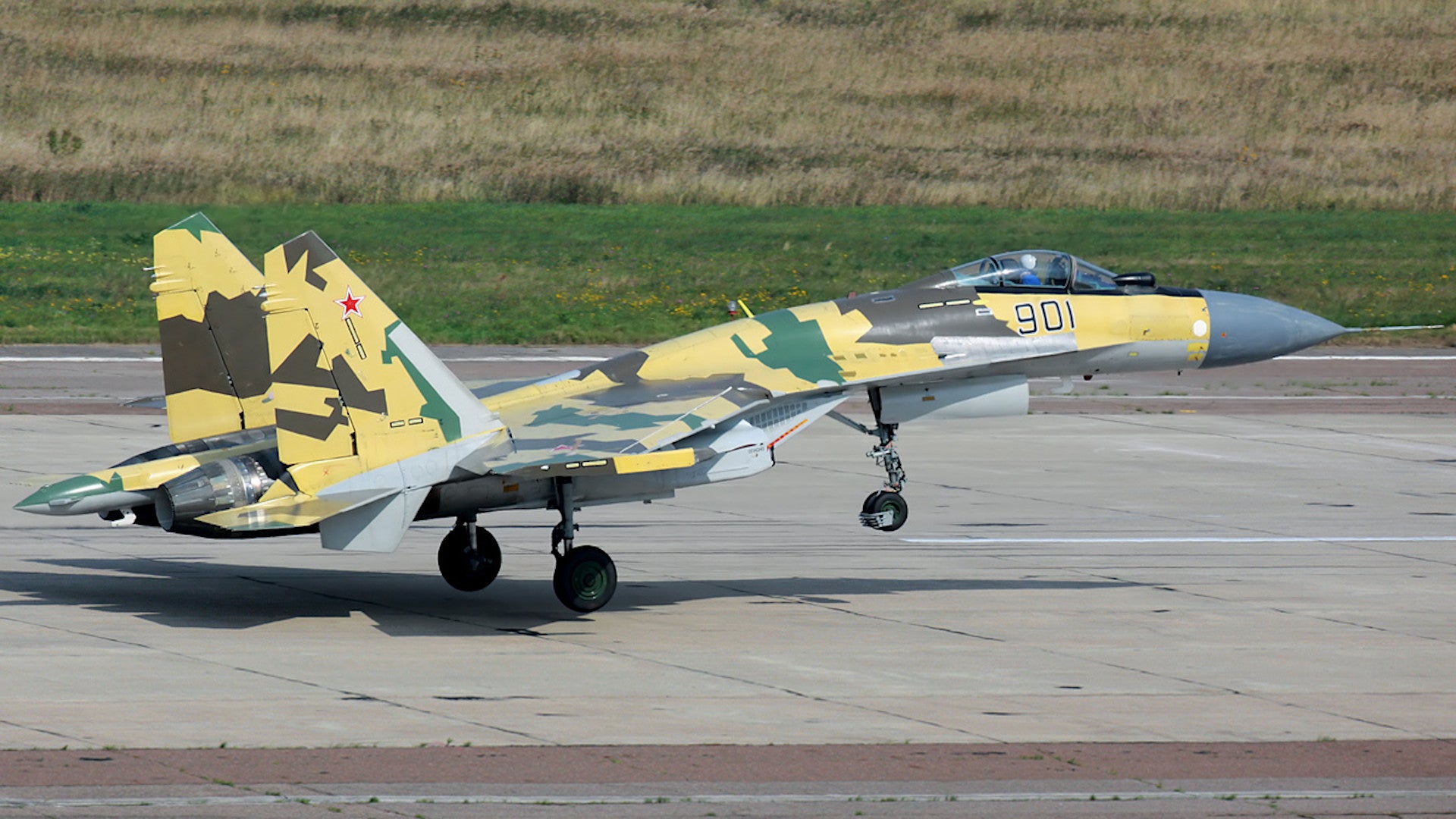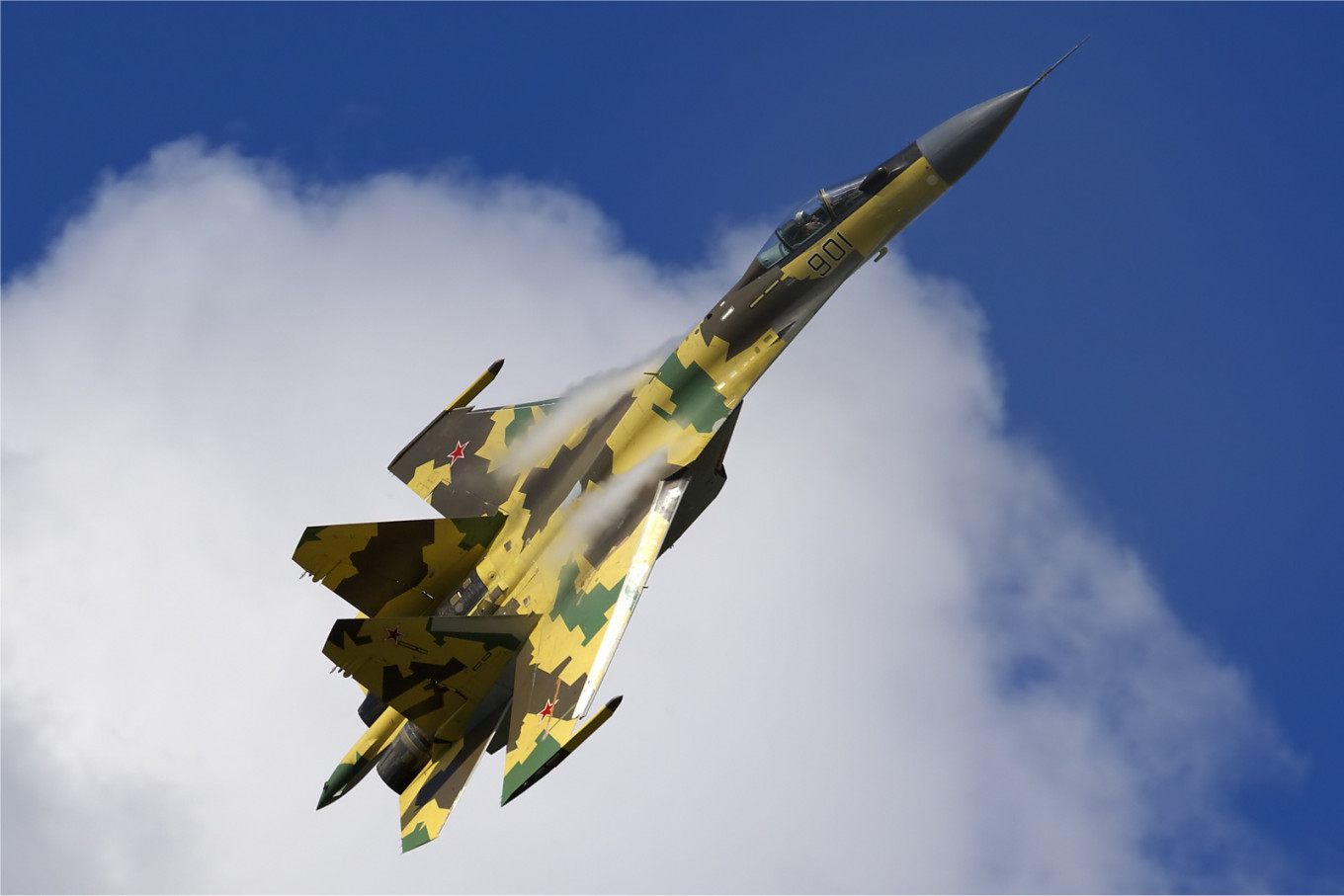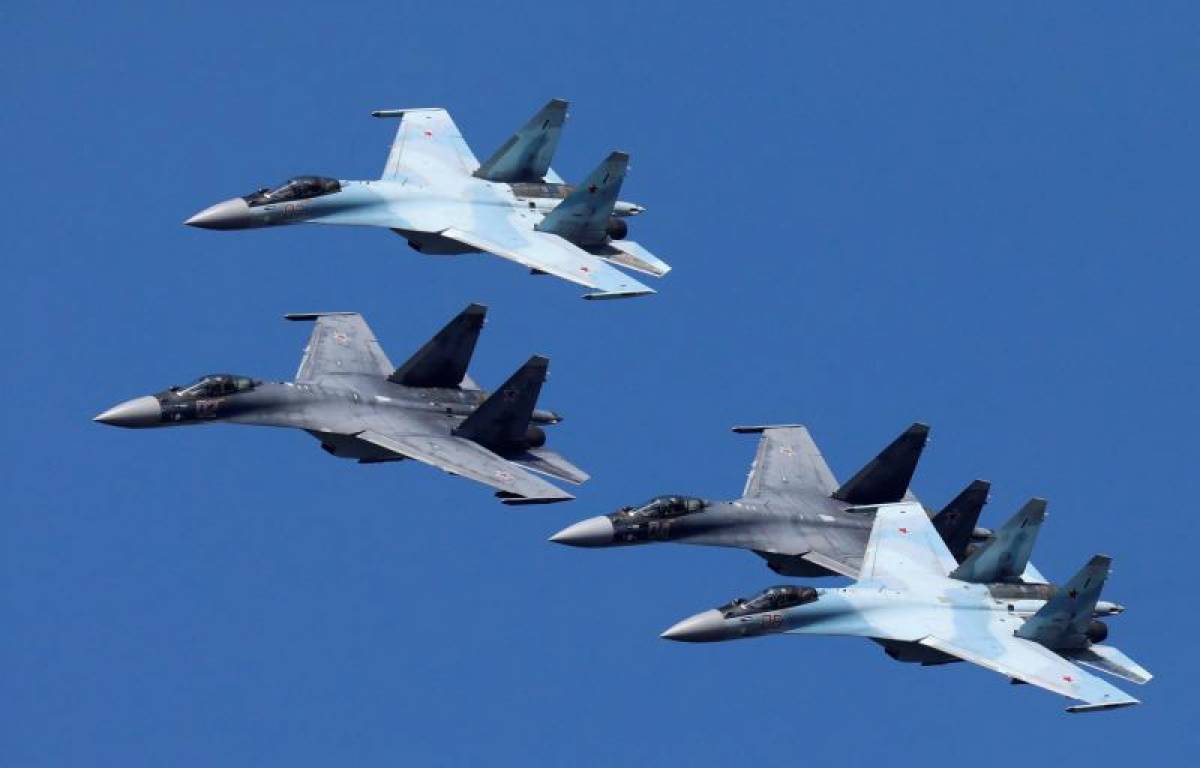Su-35 Russian Jet - The Sukhoi Su-35 (Russian: Сухой Су-35; NATO reporting name: Flanker-E) is the designation for two improved derivatives of the Su-27 air-defense fighter. It is a single-seat, twin-engine, supermaneuverable aircraft, designed by the Sukhoi Design Bureau and manufactured by Sukhoi.
This variant was originally developed by the Soviet Union from the Su-27 and was known as the Su-27M. It includes CANADA and a multi-function radar that gives it multi-role capabilities. The first prototype made its maiden flight in June 1988. After the dissolution of the Soviet Union, Sukhoi redesigned it as the Su-35 to attract export orders. Fourteen aircraft were produced and used for tests and demonstrations; One example had thrust-vectoring engines and in turn the Su-37 was redesigned. A single Su-35UB two-seat trainer was also produced in the late 1990s, similar to the Su-30MK family.
Su-35 Russian Jet

In 2003, Sukhoi began another modernization of the Su-27 to serve as an interim aircraft pending the development of the PAK FA (Su-57) program. Also known as the Su-35, this version has a redesigned cockpit and weapons-control system and has thrust-vectoring genes in place of the CANDS. The type made its maiden flight in February 2008. Although it was designed for export, the Russian Air Force became the launch customer in 2009, with the production version designated Su-35S. China's People's Liberation Army Air Force has also placed an order.
Russian Military Fighter Aircraft Su 35 Stock Vector
The first aircraft design to receive the Su-35 designation began in the early 1980s, when the Su-27 was being introduced into service with the Soviet Armed Forces. A fixed production version of the Su-27, carrying the factory code of T-10S, entered mass ("serial") production in 1983 with the Komsomolsk-on-Amur Aircraft Production Association (KnAAPO). The following year, this Su-27 version reached initial operational readiness with the Soviet Air Defense Forces.
The Sukhoi Design Bureau was instructed by the Soviet Cabinet in December 1983 to use the Su-27 for the development of the Su-27M (T-10M).
Nikolay Nikitin would lead the design effort for most of the project's existence, under the supervision of Geral Director Mikhail Simonov, who was the chief designer of the Su-27.
Broadly sharing the Su-27's bladed wing-body design, the Su-27M differs from the original version in having smaller lifting surfaces forward of the wings, visible through the addition of canards. It was first tested in 1985 using an experimental aircraft.
Russian Su 35 Pilot Who Shot Down Russian Su 30 Will Be Charge In Court With Criminal Conduct
Complete with reshaped wing leading-edge extensions, airflow was redirected to eliminate buffeting at high angles of attack and the airframe was able to sustain 10-g maneuvers (compared to 9g on the Su-27). allowed, without the need for additional structural reinforcement.
More importantly, the aerodynamic layout improved the aircraft's maneuverability, maintaining forward speed and allowing it to fly briefly behind its nose, while the comfort-stability design and fly-by A work-by-wire flight-control system was enabled. Because of this, in theory, during combat the pilot can pitch the Su-27M up to 120 degrees in two seconds and fire missiles at the target.
Other significant visual changes compared to the T-10S design included higher vertical tails, provision for in-flight refueling, and the use of a two-wheeled nose undercarriage to support the heavier airframe.

In addition to increased maneuverability, another feature that distinguished the Su-27M from the original design was a new weapons-control system. The ctrepiece of this system was the multi-function N011 Barz (literally "leopard") phased-array radar with pulse-Doppler tracking that allowed it to detect targets down in the distance. First installed on the third prototype, the radar transformed the Su-27M from an air-defense-only fighter into a multi-role aircraft capable of attacking ground targets.
Russian Fighter Jet Crashes In Siberia, Killing Two Crew Members
Compared to the Su-27's N001 Myech ("Sword") radar, which can detect up to 10 targets at a time and direct only two missiles at a target, the new radar can track up to fifty targets simultaneously. Can detect and fire missiles at six. They can direct.
The additional weight of the N011 radar on the front of the aircraft necessitated the addition of canards; Engineers would discover the aerodynamic advantages of these devices only later.
In addition, an N012 self-defense radar was mounted in the rear-projecting tail boom, the world's first aircraft with such a radar.
Other changes to the aircraft include the use of uprated turbofan engines, as well as the use of lightweight composites and aluminum-lithium alloys in the airframe.
Su 35 Fighter Jet Tests Long Range Hypersonic Missile [video]
In 1987, Sukhoi began converting the first prototype (designated T10M-1) from the T-10S airframe at its experimental plant in Moscow. Although it had canards, the first prototype, like some later aircraft, lacked many of the physical changes of the new design.
It made its first flight after conversion on 28 June 1988, piloted by Oleg Soi, followed by a second prototype in January 1989.
After the conversion of the two Su-27M prototypes, actual production of the aircraft was moved to the Far East of the country where it was carried out by KnAAPO. A third aircraft (T10M-3), the first new-build Su-27M and manufactured by KnAAPO, made its maiden flight in April 1992.

By then, the Soviet Union had collapsed, and the economic crisis that claimed Russia during the 1990s meant that original plans to mass-produce the aircraft between 1996 and 2005 were abandoned.
Iran Says It's Considering Purchase Of Advanced Sukhoi Su 35 Jets From Russia
Candus, along with the aircraft, will serve as an experimental test-bed to validate flight-control systems and thrust-vectoring technology.
By the time the Soviet Union collapsed, Sukhoi had demonstrated the Su-27M to top defense and government officials. With its debut in Western Europe at the 1992 Farnborough Airshow, the company redesigned the aircraft as the Su-35.
The aircraft then demonstrated flying overseas in an attempt to attract export orders, beginning in November 1993 in Dubai, where Viktor Pugachev flew it in front of an audience alongside the Su-30MK in a mock aviation gadget.
The aircraft then flew to Berlin and Paris and would be a regular feature at Moscow's MAKS air show.
Amazon.com: Hanghang 1/72 Scale Diecast Model Planes Su 35 Fighter Model Attack Military Aircraft For Commemorate Collection And Decorate
The Russian government approved the aircraft for export during Sukhoi's failed sales campaign in South Korea in the late 1990s and early 2000s;
As the Su-27M's flight-test program progressed, Jenners discovered that the pilot failed to maintain active control of the aircraft during certain maneuvers such as Pugachev's Cobra. So in 1995 the eleventh Su-27M (T10M-11) was equipped with a thrust-vectoring gin nozzle and the resulting Su-37 technology demonstrator made its maiden flight on 2 April 1996.
The Su-37's ability to maintain a high angle of attack while flying near zero airspeed attracted press attention.

In addition to the single-seat design, a two-seat aircraft was also produced. Working in collaboration with Sukhoi, KnAAPO's own engineers designed the Su-35UB to combine thrust-vectoring engines with features from the Su-27M. Modified from the Su-30MKK airframe, the aircraft made its maiden flight on 7 August 2000 and later served as an avionics test-bed.
Multirole Supermaneuverable Fighter Su 35
Sukhoi modified the Su-27M's canard use and the Su-37's thrust-vectoring technology and later applied it to the Su-30MKI two-seat fighter for the Indian Air Force.
The tth Su-27M (T10M-10) also served as a test-bed for the Saturn AL-41FS engine for the Sukhoi Su-57 (formerly known as "PAK FA") jet fighter.
With the need to update Russia's aging fleet of Su-27 aircraft, in 2002 Sukhoi and KnAAPO added glass cockpits and improved weapons-control systems (to accommodate a greater variety of weapons) to existing Air Force aircraft. started adding The Su-27SM, the so-called modified aircraft, made its first flight in December 2002.
The initial success of this project prompted Sukhoi to proceed with a follow-up modernization program in December 2003. Known internally as the T-10BM,
Russian Su 35 Is 'the Pinnacle'
The purpose of the program was a more complete redesign of the airframe to reduce the qualitative difference between Russian aircraft and foreign fourth-generation aircraft. The resulting design, also designated the Su-35, would serve as an interim solution for the introduction of the Sukhoi Su-57 fifth-generation fighter.
Additionally, the aircraft was to have a single-seat alternative to the two-seat design of the Su-30MK in the export market.
In many respects, the T-10BM design is externally more similar to the Su-27 than the Su-27M. During tests of the Su-27M's thrust-vectoring jibs and aerodynamic layout, Sukhoi concluded that the loss of maneuverability due to the removal of the canards—which imposed a weight penalty on the design airframe—could be compensated for. . Addition of a thrust-vectoring nozzle.

Industrial advances in the areas of avionics and radar have also reduced the weight and size of such components, thereby shifting the aircraft's level of gravity backwards.
F 16 And F 35 Proliferation In Europe, Russia Will Have To Upgrade Its Su 35 Fighter Jets
Therefore, the designers removed the canards (and dorsal air brakes) found on the Su-27M; The vertical tails, rear-cockpit hump and tail boom were also reduced in size.
With such changes, as well as the increased use of aluminum and titanium alloys and composites, designers reduced the aircraft's empty weight,
Su-35S cockpit layout: control stick with head-up display, two multi-function liquid crystal displays and HOTAS controls
While the Su-27M design had avionics to give the aircraft its nominal designation as a multi-role fighter, flight tests with the Russian Air Force
Cash Strapped Russia Sells Top Fighter To China
Russian su 35 fighter, russian fighter jets su 35, russian su 35 fighter aircraft, russian sukhoi su 35 fighter jet, su 35 jet, su 35 russian, su 35 jet fighter, russian sukhoi su 30 fighter jet, russian jet su 24, su 35 rc jet, russian air force su 35, russian sukhoi su 35
0 Comments